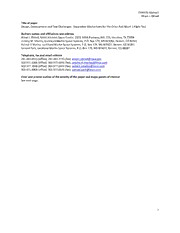
NASA Technical Reports Server (NTRS) 20110006333: Design, Development and Test Challenges: Separation Mechanisms for the Orion Pad Abort-1 Flight Test PDF
Preview NASA Technical Reports Server (NTRS) 20110006333: Design, Development and Test Challenges: Separation Mechanisms for the Orion Pad Abort-1 Flight Test
ESMATS Abstract Alison J. Dinsel Title of paper Design, Development and Test Challenges: Separation Mechanisms for the Orion Pad Abort-1 Flight Test Authors names and affiliations and address Alison J. Dinsel, NASA Johnson Space Center, 2101 NASA Parkway, MS: ES5, Houston, TX 77058 Jeremy M. Morrey, Lockheed Martin Space Systems, P.O. Box 179, MS:W3002, Denver, CO 80201 Patrick O’Malley, Lockheed Martin Space Systems, P.O. Box 179, MS:W3002, Denver, CO 80201 Samuel Park, Lockheed Martin Space Systems, P.O. Box 179, MS:W3002, Denver, CO 80201 Telephone, fax and email address 281.483.8423 (office), 281.483.2733 (fax), [email protected] 303.971.1305 (office), 303.977.0541 (fax), [email protected] 303.977.3848 (office), 303.977.0541 (fax), [email protected] 303.971.4909 (office), 303.977.0541 (fax), [email protected] Clear and precise outline of the novelty of the paper and major points of interest See next page. 1 ESMATS Abstract Alison J. Dinsel On May 6, 2010, NASA launched the first successful integrated flight test, Pad Abort-1, of the Orion Project from the White Sands Missile Range in Las Cruces, New Mexico. This test demonstrated the ability to perform an emergency pad abort of a full-scale 4.8 m diameter, 8200 kg crew capsule. During development of the critical separation mechanisms for this flight test, various challenges were overcome related to environments definition, installation complications, separation joint retraction speed, thruster ordnance development issues, load path validation and significant design loads increases. The Launch Abort System retention and release (LAS R&R) mechanism consisted of 6 discrete structural connections between the LAS and the crew module (CM) simulator, each of which had a preloaded tension tie, Superbolt torque-nut and frangible nut. During the flight test, the frangible nuts were pyrotechnically split, permitting the CM to separate from the LAS. The LAS separation event was the driving case in the shock environment for many co- located hardware items. During development testing, it was necessary to measure the source shock during the separation event so the predicted shock environment could be validated and used for certification testing of multiple hardware items. The Lockheed Martin test team measured the source separation shock due to the LAS R&R function, which dramatically decreased the predicted environment by 90% at 100 Hz. During development testing a hydraulic tensioner was used to preload the joint; however, the joint relaxation with the tensioner proved unsatisfactory so the design was modified to include a Superbolt torque-nut. The observed preload creep during lab testing was 4% after 30 days, with 2.5% occurring in the first 24 hours. The conversion of strain energy (preload) to kinetic energy (retraction) was measured to be 50-75%. Design features and careful monitoring of multiple strain gauges on each tension tie allowed a pure tensile load to be applied after stacking at the launch pad. Following installation, preload in each joint was monitored for 24 hours. Due to unforeseen complications and the influence of temperature on the portable data acquisition system, the team encountered difficulty in tracking the joint relaxation. In some cases, bond-line failure of the strain gauges occurred. The CM included the Forward Bay Cover (FBC), a thermal protection system enclosing the parachutes and other hardware packaged above the forward bulkhead of the CM. The FBC was retained and jettisoned by the FBC retention and release (FBC R&R) mechanism, which had three preloaded separation bolts and three preloaded jettison thrusters located on alternating structural gussets in the forward bay to push the separated FBC through the vehicle wake. Upon receiving the initiation signal, the three separation bolts released and the gas generators on the piston thrusters activated, causing the FBC to be rapidly pushed away from the CM. The FBC R&R thrusters were designed to withstand lateral load and applied moment during jettison of the 84 kg FBC. The development of the thrusters had issues with test fixture design for complex loading, post-test data processing and orifice erosion. Due to the low structural margin and complexity of the separable joints, testing was conducted to validate the joint load path and verify peak load through the separation bolt. A full-scale ground separation test demonstrated nearly straight separation. Both separation mechanisms utilized lanyard pull electrical separation connectors. Development testing was performed to characterize the separation behavior after exposure to the predicted environments, which exceeded the manufacturer’s recommendations. A video of the successful pad abort flight test may be downloaded here: http://www.nasa.gov/multimedia/videogallery/index.html?media_id=13781635 2
